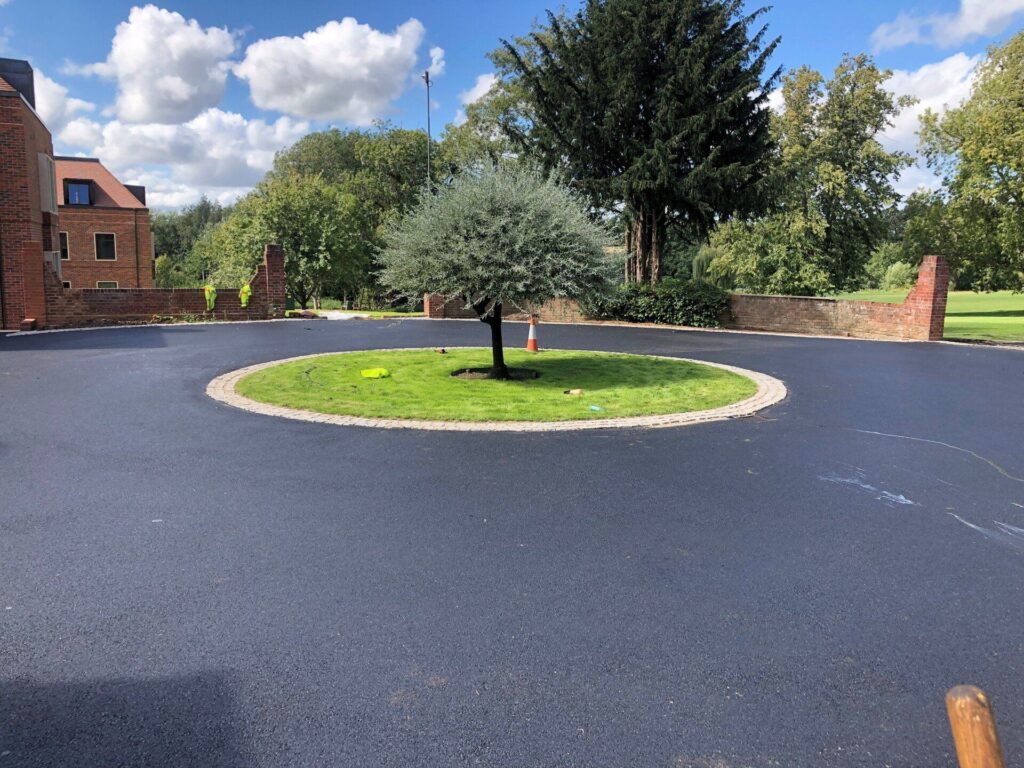Tarmac, asphalt and bitumen are all used in road surfacing and paving. But while some people use these terms interchangeably, they refer to different things. Join us as we explain what asphalt is and explore its primary uses.
Defining what asphalt is can be a little confusing. That’s because in America ‘asphalt’ refers to the substance known in the UK and Europe as ‘bitumen’.
Bitumen is a by-product of the petrochemical industry. It’s a sticky substance that’s used to bind aggregate and minerals – and it’s used in both asphalt and tarmac. So, US asphalt is an ingredient in UK asphalt!
So, what is asphalt? In the UK, asphalt consists of two basic ingredients: aggregates and binder. About 95% of the asphalt mix is made up of aggregates like crushed rock, sand, slags and gravel. The final 5% is the binder, which is usually bitumen. If your asphalt surface becomes damaged, a paving contractor will perform asphalt driveway or road repair adding filler aggregates and additional binder.
A typical asphalt driveway or road paving relies on a foundation or formation level for structure and stability. This includes both unbound and bituminous-bound materials. It allows load distribution from the traffic on the paved surface before it reaches the lower formation level.
There are different types of asphalt, so the make-up of the two ingredients can vary. The types of asphalt are categorised by the process used to bind the aggregates and the bitumen.
Asphalt is used in a wide variety of construction projects. These include:
Asphalt isn’t just used for paving roads and other surfaces, however. It has a number of less common but equally important uses too.
For example, architects often use asphalt as an ingredient for the construction of dams and reservoirs. That’s because asphalt can be an ideal solution for flood control and to prevent soil erosion.
Similarly, asphalt can be used in automotive manufacturing to prevent rust and minimise road noise in the fenders and bonnets of cars.
HMA combines around 95% aggregate (stone, sand, or gravel) with a bitumen binder. This is heated and poured onto the surface at 150-180°C. It’s the most durable type of asphalt and is used in the most high-traffic scenarios, such as on motorways and airport runways.
WMA is mixed at lower temperatures, around 20-40°C less than HMA, as so cools more slowly. Less energy is used to make it, meaning fewer fumes are produced. In fact, a reduction of around 25°C equates to approximately 75% fewer fume emissions.
This decrease in fumes provides better working conditions for the crew laying an asphalt road or driveway, and is better for the environment. WMA also uses emulsions, waxes and zeolites, making it easier to spread and pour. However, it doesn’t provide the same durability as HMA, so it’s recommended for low-traffic areas or patching.
Of all three main types of asphalt, CMA is the most affordable. It doesn’t require any heating of the aggregate at all and is used most frequently for jobs like filling potholes and pavement cracks.
This is possible because CMA uses bitumen emulsified in water. When it breaks during compaction or during mixing, it produces the coating of the aggregate. While it cures, the water evaporates. For roads that only see light traffic, CMA is a great option.
Everybody has encountered a crack in an asphalt road – and they can certainly be jarring to drive over. So you know that the material doesn’t last forever. Asphalt’s durability varies depending on temperature, the presence of moisture, the amount of traffic it undergoes and whether it’s HMA, WMA or CMA. Heavy traffic, as well as exposure to extremes of heat and cold, cause expansion and contraction of the material. The use of a sealcoat can boost the longevity of the surface, and is essential for proper maintenance.
A sealcoat protects asphalt surfacing from traffic wear and tear, motor oil, salting, water pooling and chemical staining. It also helps the surface not to crack. Cracks can cause much more profound problems if water can seep more deeply into the surface. This can make it necessary to relay the asphalt driveway or road from scratch.
If properly cared for, a well-maintained asphalt driveway can stay in excellent condition for decades!
It’s worth knowing what elements can harm your surface. Oil, motor grease, fuel, salt and transmission fluid can all break down your asphalt surface. These chemicals can also penetrate and spread beneath the surface, causing a much bigger job. The quicker you act, the less severe the impact.
Asphalt driveway and road maintenance mainly involves filling cracks and maintaining a sealcoat.
Inspect your asphalt regularly for cracks and other damage, as even hairline cracks can cause a problem. Filling cracks before they expand will keep the job small and manageable. You can use cold liquid pour asphalt crack fill to repair damage up to half an inch wide, or hot pour crack fill for gaps of up to an inch.
You’ll need to renew your sealcoating every few years depending on variables such as your usage, drainage and temperatures. Proper sealcoating prevents any loss of flexibility, as well as crumbling, oxidation and cracking. This tends to dry over a few hours.
For more substantial asphalt driveway repair or road maintenance, you can get the best results by working with a trusted road surface dressing professional. For more than 50 years, the expert team at Hazell & Jefferies has delivered high-quality asphalt surfacing for homeowners and business owners in Oxford and nationwide. Get in touch today for a free quote on your driveway or road surfacing project.

